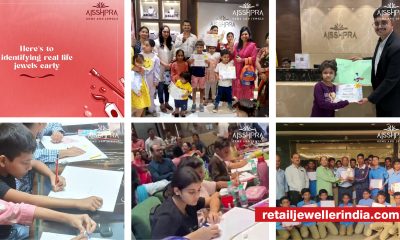Cover Feature
#RJIF: Driving profitable growth

High-power panel moderated by Soma Bhatta, Editor, Retail Jeweller India addresses ways of increasing profitability, ranging from accurate cost accounting, vendor partnerships for exclusivity, technology–preparedness, tier city expansions, multiple ordering, and increasing high-end colour gems jewellery collections that don’t retail through stores
India’s large population is giving a substantial demographic dividend, and coupled with high GDP growth, it promises to facilitate a considerable gain in the coming years, which bodes well for all sectors, including jewellery. Probing the profitability factor for legacy jewellery brands across the country, the panel named ‘Envisioning opportunities: Growing industry trends and new ideas for profitable change,’ at the Retail Jeweller India Forum 2024 held recently in Mumbai intrigued the audience.

The panellists included Darpan Anand, MD of Punjab Jewels, Saumitra Saraf, Director of Aisshpra Gems and Jewels, Mitesh Khimji, Director, Khimji Jewellers, Dr C. Vinod Hayagriv, MD and Director of C. Krishniah Chetty Group of Jewellers, Vikas Kataria, MD, DP Jewel Line, and Dev Shetty, Founder & CEO of FURA Gems.

As the growing middle class gets more aspirational, Dr C. Vinod Hayagriv highlighted the need for a deeper assessment of consumers from various age groups. “In India, the consumer age bracket starts from 12-14 years to 80 years. Such a diverse group throws up a challenge in the variety of merchandise mix,” he said. Jewellery, like several other luxury verticals in India, lacks trained merchandise management experts, he observed. He added that an Indian jewellery brand can manage its bottom line if it adheres to cost accounting of all its operations. “Every activity by the brand involves significant cost and one must have a team that looks after the cost accounting minutely so that the management and other teams can focus on jewellery retailing without worry,” Hayagriv added.

Vikas Kataria spoke about the 25-fold growth journey of DP Jewel Line from the SME IPO listing route in 2017 to NSE in 2020. “We started from Ratlam where there is not much competition. We thought of expanding to neighbouring Tier III and Tier IV cities which are untapped markets with good demand. More than 100 new smart cities are about to be made, and that’s where the opportunity lies,” Kataria said.

Congratulating Kataria on his initiative, Saumitra Saraf spoke of the contrast between the global outlook of jewellers in metros and that of gold-centric jewellers in smaller cities. “We don’t have the filtered clientele of national chain stores. We’ve expanded in Tier IV cities where the population is as low as 50,000. This year, we’ll add 4-5 stores in Tier IV cities. Periodically, it’s also important for us to have a presence in bigger cities, as that is the zone of influence,” he maintained. He talked about the product strategy of reordering the same style and increasing the design’s shelf life to reduce risk and drive higher stock turns. “We don’t replace selling items with new designs. We continue showing the same design to new customers, increasing its sell-through and eliminating the risk of dead inventory,” says Saraf.

Odisha has come a long way from an economic downturn to prosperity. As per Mitesh Khimji, the State has emerged to be the highest investment destination in 2022-23, which has also increased buying power. “Odisha has primarily been a yellow gold market and the percentage of diamonds and coloured stones five years earlier was just 1-2%. Every jewellery brand thinks about increasing market share, but at times, a brand needs to pause and reflect on improving its processes. That helps the brand in the long run,” Khimji added. Many years ago, Khimji introduced ERP and other technologies to drive expansion, efficiency and profits.
While discussing profitability, Darpan Anand said that any business survives to make a profit and a recent survey by the brand has established Punjab Jewels as the highest profitable jewellery company in their region. “A few years back, many jewellery brands were popping up in our vicinity and everyone was offering lower prices. As a business, you’ll have to ensure profit and growth. From the smallest to the biggest companies, it is always about profit. We have introduced ranges that are exclusive to us. We have been able to do this by striking partnerships with relatively small vendors who are equally keen to partner for growth,” Anand said.

Addressing concerns regarding profitability, Dev Shetty shared how precious coloured gemstones are a reliable category that secures retailers’ bottom lines. “FURA’s consistent supply of precious coloured gemstones backed with origin certification will help retailers increase the bottom line from single-digit to double-digit growth,” Shetty emphasized. Shetty explained how Indian retailers must explore creating high-end jewellery lines with precious colour gems. He said, “Many international luxury brands create exclusive collections with colour gemstones unavailable in the store. It piques the curiosity of elite customers who get special previews of such collections while retailers command a handsome premium.

The perks of colour gemstones are varied, maintained Shetty, as FURA Gems is solving the age-old problem of supply and organised retail of colour gemstones with Australian sapphires, Mozambican rubies, Colombian emeralds, and the latest product of pink sapphires in partnership with key manufacturers and renowned retail brands of the country. “Colour gemstones add excitement to any form of jewellery, be it precious metal or diamond ranges.”







 Daily News2 months ago
Daily News2 months agoPC Jeweller to subdivide shares with 1:10 stock split amid record-breaking growth

 Daily News2 months ago
Daily News2 months agoKalyan Jewellers unveils limited edition ‘Pushpa’ collection ahead of Pushpa 2 release

 Daily News2 months ago
Daily News2 months agoBhima Jewellery sets Guinness World Record with ₹200 Crore Single-Day Sales on centenary celebration

 Daily News2 months ago
Daily News2 months agoKalyan Jewellers launches Giridih store, targeting its growing customer base in Jharkhand























